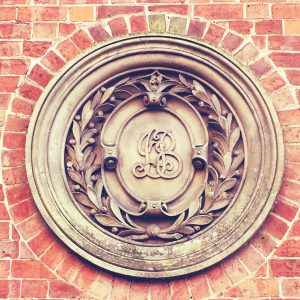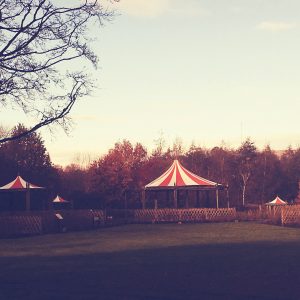Wilmont House stands on the junction of Dunmurry Lane and Upper Malone Road near Dunmurry, Co. Antrim. The present two-storey Victorian house designed by Thomas Jackson dates to 1859. An older house stood in what is now the barbecue area from 1740.
In the mid-18th century, Scottish settler William Stewart established an estate on the site. He owned another large house nearby at Ballydrain. The Stewart family were farmers and known for growing carrots in the early 1800s. This was an unusual harvest for the time in Northern Ireland. The family even had an early threshing machine dating back to 1811.
Until 1815, the land around the Stewart estate served as a bleaching green for linen. These were a common site around the Lagan Valley. Many large grassy area saw use as long strips of brown linen bleached to their renowned white colour.
When visiting Wilmont House, look out for a false window painted on the brickwork over the porch. This balances out the design of the house’s facade. You can also see the initials of James Bristow on the side of the building.
The Bristows were influential bankers and descendants of an 18th century Mayor of Belfast. The Bristows sold the house to Robert Henry Sturrock Reade in 1879. His son would later sell the house and surrounding land to Sir Thomas Dixon. Sir Thomas Dixon and Lady Edith Stewart Dixon bought the property in 1919. The parklands still bear their names although a handover to Belfast Corporation occurred in 1959. The 134 acre park is most famous as the venue for the City of Belfast International Rose Trials.
Many famous visitors stayed at Wilmont House over the years. The famous Antarctic explorer Captain Robert Falcon Scott visited in 1904. In 1934, the house became the temporary home of the Governor of Northern Ireland after Government House in Hillsborough, Co. Down suffered fire damage.
American Forces
The following American forces were based in Wilmont House, Dunmurry, Co. Antrim between 1943 and 1944. If you have more information on them, please get in touch.
| Start Date | End Date | Units |
|---|---|---|
| 28th January 1942 | 1st June 1942 | Headquarters United States Army Northern Ireland Force (USANIF) |
| 1st June 1942 | Headquarters V Corps | |
| 1st June 1942 | 20th December 1942 | Headquarters Northern Ireland Base Command |
| May 1942 | Detachment 205th Military Police Company | |
| May 1942 | Detachment 22nd Quartermaster Car Company | |
| May 1942 | Detachment B 827th Signal Service Company | |
| 5th December 1942 | 26th July 1943 | Headquarters and Headquarters Company, 3rd Battalion, 156th Infantry |
| 16th December 1942 | 22nd November 1943 | General Supply Depot G-10 |
| 8th July 1943 | Detachment E 162nd Signal Photographic Company | |
| 2nd October 1943 | 15th June 1944 | Northern Ireland Base Section |
| 11th October 1943 | 25th November 1943 | Headquarters and Headquarters Detachment, 544th Quartermaster Service Battalion |
| 11th October 1943 | 27th December 1943 | Company A, 544th Quartermaster Service Battalion |
| 11th October 1943 | 25th November 1943 | Company B, 544th Quartermaster Service Battalion |
| 11th October 1943 | 25th November 1943 | Company D, 544th Quartermaster Service Battalion |
| 18th October 1943 | 19th November 1943 | Headquarters and Headquarters Detachment, 307th Quartermaster Battalion |
| 18th October 1943 | 3rd December 1943 | Detachment 818th Signal Port Service Company |
| 18th October 1943 | 303rd Quartermaster Railhead Company | |
| 14th November 1943 | 18th July 1944 | 576th Signal Construction Operations Platoon |
| 7th December 1943 | 3rd May 1944 | 3028th Quartermaster Bakery Company |
Wartime at Wilmont House
At 1000hrs on 28th January 1942, Headquarters of United States Army Northern Ireland Force (USANIF) opened at Wilmont House. The house had already seen use as a base for British troops before the American troops’ arrival. Records estimate 290 men could have been at the Wilmont base.
On the same day, United States Army Forces British Isles (USAFBI) opened a subordinate signal office at the Dunmurry site. Colonel Floyd T Gillespie and Staff Sergeant Joel M Hirsch oversaw this operation. United States Army 63rd Signal Battalion provided the men. From Wilmont, the US Army established radio channels to Iceland Base Command. Transmitters, receivers, and teleprinters made up some of the equipment used.
On 9th February 1942, 112th Engineer Battalion began to expand the site. Well-constructed blast walls protected the doors and windows of Wilmont House. Men stayed Nissen huts around the gardens. Quonset huts acted as administration buildings. Completion of this section of the base took place on 27th February 1942.
An Officer Messenger service began between Wilmont House and other US Army headquarters on 10th March 1942. At the same time, authorities looked at basing the United States Army Air Force in Dunmurry but this proposal went no further.
In April 1942, 107th Engineer Battalion arrived and carried out more construction work, making the site even larger. The new builds included more Nissen huts for accommodation and an Anti-Aircraft gun emplacement. The work finished on 16th May 1942 and the Dunmurry site held 184 officers, 641 enlisted men, 17 American Red Cross personnel and 10 civilians.
Military Reorganisation in Dunmurry
There was much reorganisation of troops at Dunmurry, Co. Antrim during the United States Army’s time at Wilmont House. On 1st June 1942, it became Headquarters Northern Ireland Base Command, a centre for all administrative and supply details. This restructuring lead to the base becoming the permanent area command headquarters in Northern Ireland.
At the same time, US Army V Corps established a headquarters at Wilmont House. This lasted only a short time before their move to Brownlow House, Lurgan, Co. Armagh on 8th June 1942. In Dunmurry, Brigadier General Leroy P Collins was the most senior officer. Colonel Leavey acted as his Chief of Staff.
Between 20th July 1942 and December 1942, Northern Ireland Base Command (NIBC) became known as Northern Ireland Base Section (NIBS). That December, Northern Ireland fell under the control of Western Base Section, Services of Supply. By this time in November 1942, most of the first American GIs to land in Northern Ireland had moved on. A small number remained to take care of administration and supplies for Army Air Corps units, and to complete construction projects. The radio link with Iceland remained although by now it had grown to include 3 cross-channel teleprinter circuits, 11 terminal teletype machines, and 6 teleprinter machines. 3rd Battalion, 156th Infantry took on guard duties. On 16th December 1942 General Depot G-10 came into being. Records give its location as Wilmont Park.
The Second Wave
In 1943, the second wave of American troops arrived in Northern Ireland. The number of GIs lead to the reactivation on 5th October 1943 of Northern Ireland Base Section (NIBS). Brigadier General Leroy P Collins took charge once again.
General Supply Depot G-10 absorbed Northern Ireland District Headquarters personnel at Wilmont House. G-10 reactivated on 16th August 1943 under the command of Colonel Irwin S Dierking. The depot became inactive on 23rd November 1943. The General Supply depot designation switched to Q. All personnel from G-10 in Dunmurry transferred to Depot Q-111 at nearby Finaghy, Co. Antrim. Dierking remained at Wilmont House on the special staff of Northern Ireland Base Section until January 1944.
By May 1944, most of the United States Army forces were bound for D-Day preparations. District XXXVI at Wilmont House, Dunmurry was the last remaining in Northern Ireland, retaining communication facilities until June 1944.
Once again, the base relinquished its headquarters role and fell under control of Western Base Section Headquarters. From 1942 to 1944, Wilmont House had been a vital part of the US Army’s base in Northern Ireland. Now, little remains at the site to show its wartime importance or technological prowess. Thousands of tourists enjoying peaceful walks and stunning views of ornate gardens can only imagine the scene.




